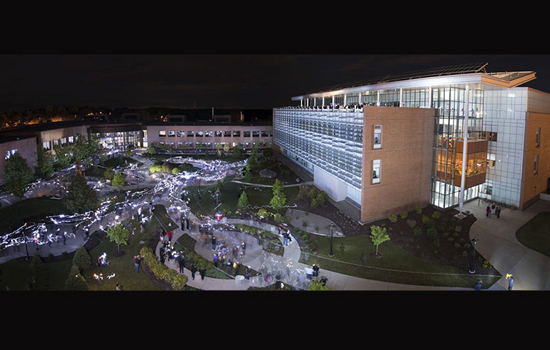Thousands come out to illuminate RIT campus
Photo team captures spectacular nighttime image of Sustainability Institute Hall and quad
RIT Big Shot Team
Nearly 3,000 volunteers turned out for RIT’s 30th Big Shot photo project on Saturday night. The image captured RIT’s Golisano Institute for Sustainability, Louise M. Slaughter Hall and surrounding quad.
Rochester Institute of Technology’s Golisano Institute for Sustainability, Louise M. Slaughter Hall and surrounding quad basked in a sea of light Saturday night, helping make RIT’s 30th Big Shot photograph a summertime success.
More than 2,900 volunteers, including nearly 1,500 RIT students and 130 alumni, provided the primary light source for the Big Shot image while RIT photographers shot an extended exposure of RIT’s “living lab” dedicated to sustainability, Center for Integrated Manufacturing Studies (CIMS) and quad.
This year’s final image is a 30-second exposure at f11.
“What a spectacular job by this wonderful crowd that came out for one of RIT’s signature projects, and we couldn’t be more thrilled with the outcome of this year’s photograph,” said RIT professor Michael Peres, associate chair of the School of Photographic Arts and Sciences (SPAS) at the College of Imaging Arts and Sciences. He led the event with SPAS colleagues Willie Osterman, Mike Dear and Christye Sisson.
Peres noted that capturing the image culminated many months of hard work, adding, “This is a community art project and we couldn’t do it without the support of everyone who came out tonight and our sponsors. We’ve created a once-in-a-lifetime photograph of our ‘living lab’ and quad. It’s quite a night for RIT.”
He added, “This photo marked our first computational image using two cameras with matched lenses on a single tripod to create a panoramic effect.”
Computational photography refers to image capture involving processing and manipulation techniques that enhance or extend the capabilities of digital photography, such as panoramas.
Due to the large number of windows, Peres positioned lighting teams within both GIS and CIMS to help illuminate the buildings from the inside. About three-dozen SPAS students and alumni were spotted on the GIS building’s “green roof” to accentuate its unique rooftop garden.
Nikon Professional Services once again supported the project, loaning high-end photographic equipment and sponsoring memento prints for all who attend. The Big Shot photograph was produced using two Nikon D810 bodies. Profoto also provided specialized lighting equipment, including powerful battery-operated electronic flash systems
The Big Shot is often described as “painting with light” because participants are asked to “paint” or shine their light source onto a particular exterior area of a landmark while the photograph is taken. The light sources are primarily either handheld flashlights or camera flash units. Participants were tasked with continuously “painting” their assigned area of the scene Saturday night while RIT photographers shot an extended exposure. The photo was taken at 9 p.m.
Since RIT started its Big Shot project in 1987, university photographers have captured such landmarks as AT&T Stadium (formerly Cowboys Stadium); The Alamo, San Antonio, Texas; the U.S.S. Intrepid, New York City; and the Royal Palace, Stockholm, Sweden.
RIT’s Big Shot event began as a way to teach students about electronic flash photography. RIT’s School of Photographic Arts and Sciences is nationally recognized for its degree programs.
To view nighttime images visit the Big Shot website.







